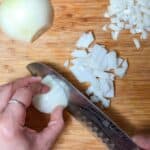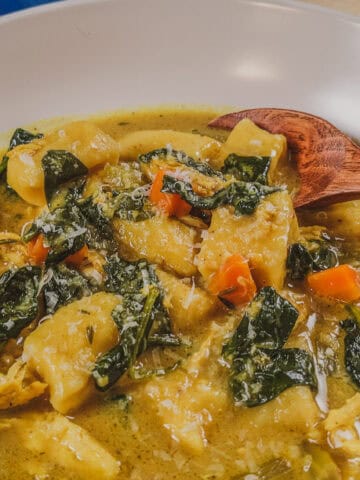Become a Better Cook! This Just Maika Cooking: Cook’s Notebook section will focus on everything related to the Scoville Scale and Chili Peppers connected to all my recipe posts, updated frequently.

Jalapeno Mammoth from my Garden
Table of Contents
Jump to:
- What is the Scoville Scale?
- Is the Carolina Reaper Really the Hottest Pepper?
- Scoville Scale (Average SHU Range) with Place of Origin/Popularity
- Popular Chili Pepper Pairings
- Sound Like Chili Peppers but Are Not
- Pepper Pastes with SHU
- What Helps Relief Chili Pepper Heat from Spicy Foods?
- What is Your Favorite Hot Sauce? I Can't Live without Spicy Food!
- Cook's Notebook: Become a Better Cook!
- Spicy Recipes
- Leave a Comment or Ask a Question
What is the Scoville Scale?
It's a popular scale used to measure a chili pepper's heat level. The higher the number on the Scoville scale, the hotter. It's on a scale because the pepper's heat falls under a particular range. The chilies get their heat from the capsaicin, responsible for the irritation, pain, or burning sensation you may feel.
All spicy peppers have a certain concentration of capsaicin—hence the use of SHU, Scoville Heat Units, to determine where it falls on the scale. So let's give Scientist Wilbur Scoville, an American pharmacist, a shout-out for creating this method's birth in 1912. The Scoville Scale below shows the Carolina Reaper as the hottest chili pepper.
Is the Carolina Reaper Really the Hottest Pepper?
There are many hotter peppers, but the hottest pepper consumed is the Caroline Reaper. On September 17, 2022, a brave man named Gregory Foster ate 10 of these bad boys in 33.15 seconds.
Another guy, Mike Jack, ate 50 in 6.49 seconds on November 5, 2022. Both are in the Guinness World Records. Two of the many peppers hotter than the Caroline Reaper are the Komodo Dragon 1, 400,000 to 2,200,000 SHU, and Pepper X, with 3,1800,000 SHU.

Macho Pepper from my Garden
Scoville Scale (Average SHU Range) with Place of Origin/Popularity
| SHU | Pepper Name | Origin | Recipes |
| 2,000,000 | Carolina Reaper Pepper | South Carolina, United States | |
| 750,000-1,5,000 | Trinidad Moruga Scorpion | Moruga, Rinanadad and Tabago | |
| Naga Viper Pepper | Cumbria, England | ||
| Infinity Chili | Grantham, Lincolnshire, England | ||
| Bhut Jolokia / Naga Jolokia, aka Ghost Pepper | Northeast India: Assam, Manipur, and Nagaland | ||
| 350,000–750,000 | Red Savina Habanero | California, United States | |
| 100,000–350,000 | Habanero Chili | North of South America in the Amazon | Creamy Spicy Sweet Potato Chicken and Dumplings |
| 100,000–350,000 | Scotch Bonnet Pepper | West Africa | Scotch Bonnet Smoked Turkey Collard Greens Beans Soup |
| Macho Pepper | Oaxaca and Yucatan Region of Mexico | ||
| 60,000–100,000 | Malagueta Pepper | Brazil | |
| 50,000–100,000 | Bird's Chili, aka Thai Chili Pepper | South East Asia | |
| 30,000–50,000 | Tabasco Pepper | Mexico | |
| 30,000–50,000 | Cayenne Pepper | Cayenne, French Guiana | Butternut Squash Chicken Chili |
| 30,000–50,000 | Crushed Red Pepper, Cayenne Type | Spicy Basil Pesto | |
| 25,000–50,000 | Aji Amarillo | Peru | |
| 25,000–50,000 | Calabrian Chili Peppers | Calabria | Easy Spicy Calabrian Italian Chicken Sausage Bolognese |
| 15,000–30,000 | Chile de Arbol | Mexico | |
| 10,000–25,000 | Serrano Pepper | Puebla and Hidalgo, Mexico | |
| 10,000 | Aleppo Pepper | Aleppo, Syria | Easy Aleppo Pepper Spiced Dill Lentil Chicken Soup |
| 10,000 | Chongyang Chili Pepper | South Korea | |
| 2,500–10,000 | Jalapeño peppers / Chipotle | Mexico | Jalapeno Pesto and Argentinian Shrimp Pasta |
| 2,500–5,000 | Guajillo Chili | Mexico | |
| 1,000–5,000 | Baklouti Pepper | Tunisia | |
| 1,000–2,500 | Poblano Pepper / Ancho | Puebla, Mexico | |
| 500–1,000 | Cubanelle | Caribbean: Cuba, Dominican Republic, Haiti, Peurto Rico, and Italy | |
| 500–1,000 | Beaver Dam Pepper | Wisconsin, United States | |
| 0–500 | Pimiento | South America | |
| 50–200 | Shishito Peppers | Japanese | Shishito Eggplant Shrimp Stir-Fry |
| 1–1,000 | Medusa Peppers | South America | |
| 0 | Bell Pepper / Paprika | Central and South America | |
| 0 | Peperone Crusco | Basilicata, Italy |

Medusa Pepper Plant in my Garden.
Popular Chili Pepper Pairings
With Global Cusines in the United States: Explore the vibrant world of chili peppers and their perfect pairings with global cuisines in the United States. This section jumps into the unique flavors and culinary traditions of various regions, highlighting how different chili peppers can elevate and complement dishes from around the world.
Why the United States? The phrase "in the United States" emphasizes that the chili pepper pairings are explored from the perspective of someone in the U.S., as culinary preferences and ingredient availability can vary significantly in other parts of the world.
| Aleppo Pepper | Meditterean and North African Cuisine |
| Bird's Chili aka Thai Chili Pepper | South East Asian Cuisine |
| Habanero Peppers | Caribbean Cuisine |
| Jalapeño peppers | Very Versatile |
| Serrano Pepper | East African, Indian, and Mexican Cuisine |
| Scotch Bonnet Pepper | West African and Caribbean Cuisine |
My easy-to-read chart showcases popular chili peppers and the regional cuisines they enhance, offering you a guide to adding bold and exciting flavors to your cooking. Discover new ways to use your favorite peppers and uncover fresh combinations that will transform your cooking into a global culinary adventure.
Whether you're looking to spice up a Mexican-inspired meal, add a kick to an Asian stir-fry, or bring warmth to a Mediterranean dish, you'll find inspiration here.
Maika

Picked Medusa and Macho Peppers from my Garden. Mostly, Medusa is on the left, and Macho is on the right.
Sound Like Chili Peppers but Are Not
These papers actually are berries and, therefore, do not have Scoville units since they do not have capsaicin.
- Sansho Pepper (Japanese) / Chopi Pepper (Korean) - Citrusy Tingling Heat
- Tellicherry Pepper aka Black Pepper (Native to South Asia) - Pungent Kick of Heat
- Szechuan Pepper (Chinese) - Tingling Heat

Unripe Medusa Peppers in My Garden
Pepper Pastes with SHU
| Pepper Paste | Chili Pepper | SHU |
| Sambal Olek | Commonly Red Chili Peppers, Bird's Eye Chili | 50,000–100,000 |
| Gochujang | Cheongyang | 10,000–25,000 |
| Chipotle in Adobo | Chipotle (Dried Jalapenos) | 2,500–8,000 |
| Zhug / Shug / S'kug | Unsure, but serrano and jalapenos are commonly used | 2,000-8,000 |
| Harissa | Baklouti Pepper | 1,000-5,000 |

Ripe (red) and Unripe (green) Macho Peppers in my Garden.
What Helps Relief Chili Pepper Heat from Spicy Foods?
Some say to drink a glass of milk or sour cream or eat yogurt, probably due to their acidic component. Other acidic foods to help with relief can be lemons and tomatoes. Different ways can be using a sweetener like sugar, water, or honey.
Another way is through fatty foods like olive oil or peanut butter. Avoid using water. Water is actually an aid for the heat since it is the component causing the burning sensation. Capsaicin is oil-based; it doesn't do anything but make it worse by spreading around your mouth—and you don't want that!
However, in the long run, if you enjoy spicy foods, eating them more often can help your body tolerate the heat intensity, and that tongue burn won't be quite so noticeable.

Haitian Habanero Pepper Sauce by Men Pa’w
What is Your Favorite Hot Sauce? I Can't Live without Spicy Food!
I can finish half a bottle of Cholula Hot Sauce on tacos. Submerge my wings in Frank Red Hot Sauce. Dab my boiled eggs with Tobasco. I can't eat my pollo a la plancha with black bean sauce and rice without a good habanero sauce. And I will not use one of the sauces with a different meal. Good peppers combine sweetness and smokiness, making them unique and perfect for certain dishes.
Cook's Notebook: Become a Better Cook!
What else do you want to learn about today?
Spicy Recipes
Are you looking for spicy recipes? Check these out:
- Green Seasoning Recipe | Epis - Haitian Style
- Quick Spicy Potstickers | Chili Momo Tibetan Style
- Creamy Curry Chicken Gnocchi Soup | Caribbean Style
- One-Pot Curry Meatball Soup with Ground Turkey and Kale
Leave a Comment or Ask a Question
I'd love to hear your thoughts, questions, or experiences with the Scoville Scale and Chili Peppers—leave a comment or question and get a response from a professionally trained chef!














Leave a Reply